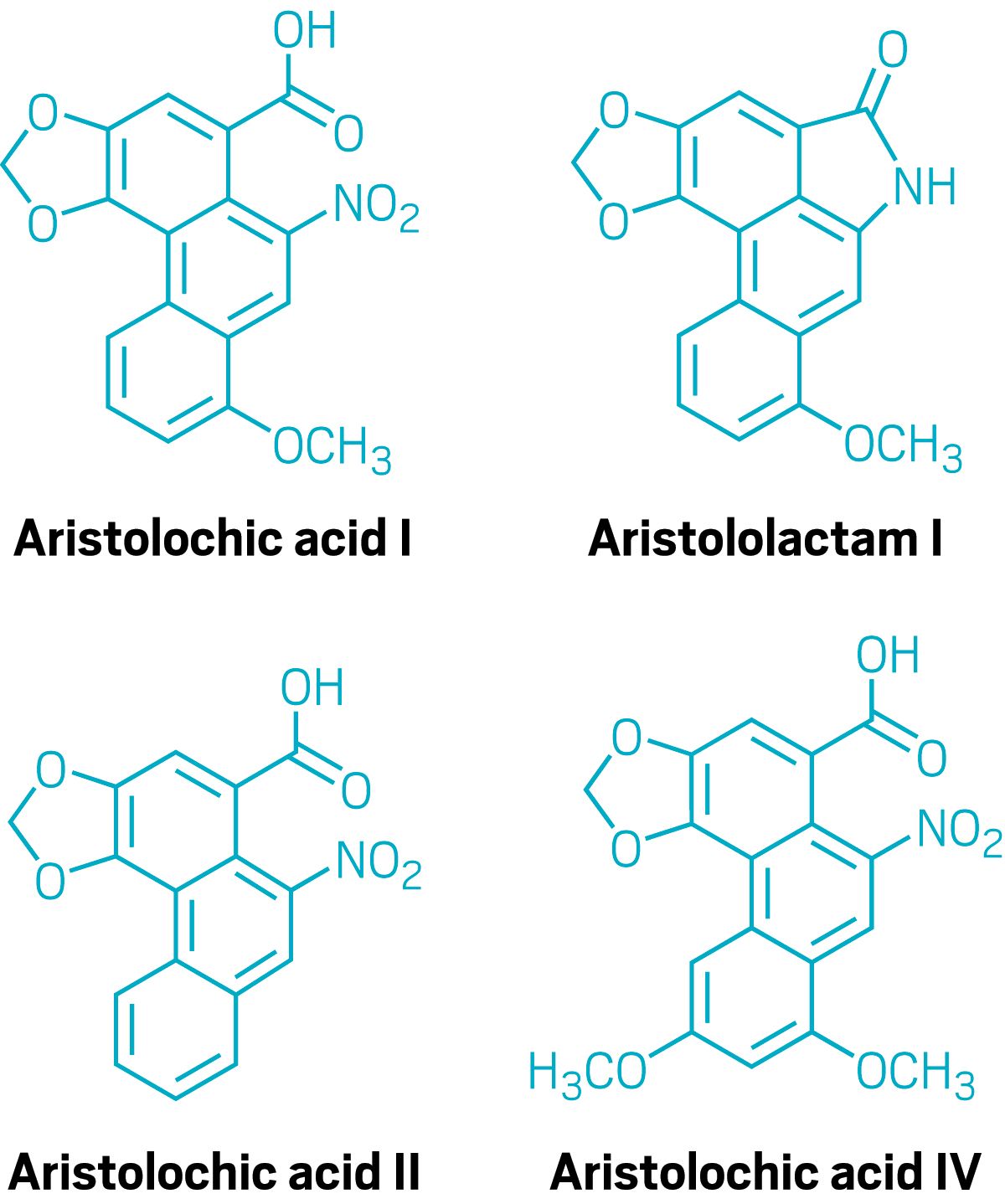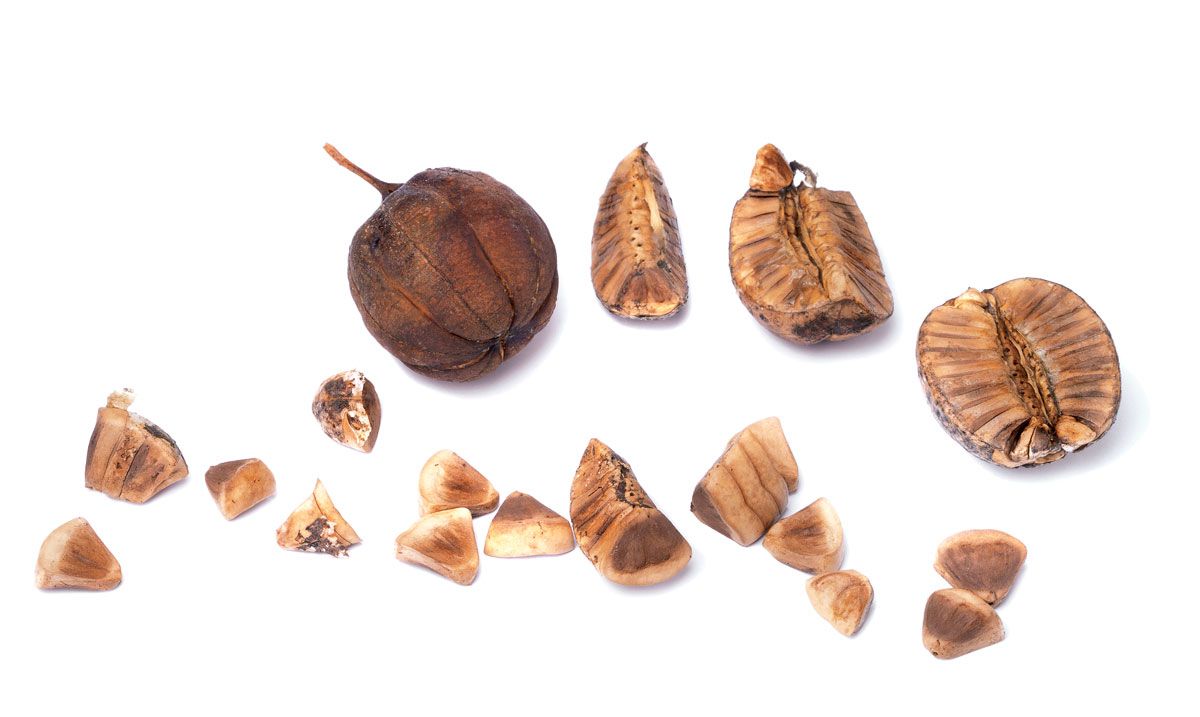
Credit: ACS Cent. Sci
Aristolochia clematitis grows mingled with wheat in fields near villages in the Balkan Peninsula.
In the bucolic farming villages that dot the countryside of Europe’s Balkan Peninsula, a hardy plant with a reedy stem, heart-shaped leaves and yellow bugle-like flowers grows thick in the wheat fields. The plant, Aristolochia clematitis—more commonly known as birthwort—can surely be called beautiful, but within it lurks a poison. Over the past few decades, researchers have identified a family of compounds in the plant, collectively called aristolochic acids (AAs), as the cause of a severe kidney disease endemic to this region, as well as the cause of multiple types of cancer.
Epidemiologists have estimated that the disease, dubbed Balkan endemic nephropathy (BEN), might affect about 100,000 people in the region. But scientists have come to believe the disease is vastly more widespread. Somewhere between 390 million to 2.7 billion people worldwide suffer from kidney disease with no known cause, and Nikola Pavlović, a nephrologist at the University of Niš who has studied BEN for 5 decades, believes that AAs might be involved in a high proportion of that kidney disease.
Meanwhile, Arthur Grollman, a chemical biologist at Stony Brook University who elucidated how AAs mutate DNA, now estimates that around the world—particularly in Asia, where Aristolochia plants are widely used in traditional medicines—some 10–100 million people may be at risk of a variety of cancers instigated by the molecules. “My estimate is very, very conservative,” Grollman says.
Plants in the genera Aristolochia and Asarum have been used in medicines worldwide for millennia. Records suggest that ancient Greeks and Romans used them to treat postpartum bleeding, for example. These plants naturally produce a mixture of AAs, compounds characterized by a series of three aromatic rings with a handful of substituents, as toxins to fend off attacks by insects. Concentrations of all these molecules vary widely among species, and even among different parts of a given plant.

Credit: ACS Cent. Sci.
Aristolochic acid I is metabolized and reacts to make carcinogenic DNA adducts containing aristolactam I. Aristolochic acids II and IV are also common in Aristolochia clematitis, but their toxicity is less understood.
Whatever their beneficial properties, ingesting even tiny quantities of an AA cocktail over a period of decades can cause severe kidney toxicity—and, eventually, cancer. A key culprit is a particular compound called aristolochic acid I. Humans metabolize aristolochic acid I to an intermediate that binds to DNA, resulting in mutagenic adducts of the DNA base adenine and the AA derivative aristolactam.
AA poisoning is “one of the best-characterized systems of how exposure to a toxin can give rise to cancer and other diseases,” says Yinsheng Wang, a chemist and environmental toxicologist at the University of California, Riverside. Some researchers have compared the cumulative disease-causing effects of AAs to those of aflatoxin, which causes liver cancer and is produced by fungi that infect food crops.
Yet several mysteries remain about AA-induced disease, such as exactly how people are exposed to AAs, what spectrum of cancers AAs cause, and what role the full suite of compounds plays in disease. Researchers are now beginning to put these additional pieces together. They hope the full picture will allow them to understand just how many people AAs have harmed and how to prevent future illness.
A medical mystery
Bulgarian clinicians first described the kidney pathology that characterizes BEN in the late 1950s. Between ages 40 and 60, the first symptoms emerge. Initially, those symptoms are nonspecific: weakness, pallor, mild lower-back pain, and a coppery-brown tint to the skin. Eventually, people develop anemia, mild hypertension, and chronic kidney disease that is treatable only with dialysis or a kidney transplant. In BEN’s final stages, Pavlović says, “you will find the smallest known kidneys in nephrology”—around one-tenth the weight of a normal adult male kidney, most of it scar tissue. Pavlović first started studying BEN in the early 1970s as a medical student in Niš, where many patients had it. It was a mystery, with a million-and-one proposed causes—“trace elements, blood groups, immunological disorders, heredity, enzymes, metabolic disorders, all sorts of things,” Pavlović says.
None of the proposed causes stuck, though, until the early 1990s, when women visiting a Belgian weight-loss clinic suffered severe kidney damage after consuming an herbal supplement containing AAs. One of Pavlović’s colleagues noted that the symptoms were similar to a sped-up version of BEN and asked him whether the compounds had ever been implicated in the disease. Indeed, they had, Pavlović told him—2 decades earlier, by Pavlović’s histology professor, Milenko Ivić, who had fed rabbits an extract of A. clematitis and found it made their kidneys shrink.
In 2000, researchers reported that a large proportion of people who took the weight-loss supplement developed severe renal disease, and many of those developed urothelial cancer affecting the cells lining the urethra and bladder (N. Engl. J. Med. 2000, DOI: 10.1056/NEJM200006083422301). Grollman, in Stony Brook, read the study. He knew nothing about AAs but had long been involved in efforts to regulate herbal supplements because of their underestimated potential toxicity. The comparison to the mysterious symptoms of BEN caught his eye. “I just picked up and went to Croatia,” he says.
AA poisoning is “one of the best-characterized systems of how exposure to a toxin can give rise to cancer and other diseases.”
Yinsheng Wang, a chemist and environmental toxicologist at the University of California, Riverside
Grollman expected to learn that Balkan villagers formulate herbal remedies from Aristolochia plants. He found that they do occasionally brew tea from birthwort to treat conditions as diverse as gout and snakebites. But he also saw Aristolochia plants growing as weeds amidst grain the villagers milled and used to bake bread. He began to suspect a hypothesis proposed by Ivić that coharvesting the weed and wheat led Aristolochia material to be baked into bread—and that this was the main route of AAs exposure.
Over the next few years, Grollman teased out the biochemical pathway by which metabolically activated aristolochic acids react with DNA to form adducts in the kidney that can eventually turn into cancer-causing mutations. His team also looked at the genomes of people from the Balkans with nephropathy and identified the compound’s mutational signature—a distinct pattern of changes to DNA—in p53, a gene involved in cell cycle regulation that’s often implicated in cancer (Proc. Natl. Acad. Sci. 2007, DOI: 10.1073/pnas.0701248104). They also found a direct link from such mutations to upper-tract urothelial cancer (Sci. Transl. Med. 2013, DOI: 10.1126/scitranslmed.3006200). What’s more, they found that 83% of 151 patients with urothelial cancer in Taiwan had tumors that carried AAs’ signature p53 mutations—thereby putting the problem of AA toxicity on the map more globally.
Birthwort in the Balkans is just one source of AAs; countless species of Aristolochia plants grow around the world. The US Food and Drug Administration banned AA-containing supplements after the 2000 study and, based in part on Grollman’s work, authorities in Taiwan and other Asian countries have restricted some products containing AAs. China removed all AA-containing herbs from their official pharmacopeia just this year, Grollman notes. But herbal remedies containing them can still be purchased widely on the internet, says Steven Rozen, a computational and cancer biologist at Duke–National University of Singapore Medical School.
Over the past few years, evidence has mounted that the carcinogenic effects of AAs extend far beyond urothelial cancers, which are relatively rare. In 2017, Rozen and his colleagues examined 98 liver tumor tissue samples from Taiwan and reported that 76 of them carried AAs’ mutational signature (Sci. Transl. Med. 2017, DOI: 10.1126/scitranslmed.aan6446). “We were really stunned to find that,” Rozen says.
There is scant data so far to estimate how much AA exposure elevates liver cancer risk, Rozen explains, but the risk may be higher in people with hepatitis A or B, which are common in East Asia. Liver cancer genomes have been widely sequenced from cases around the world, and researchers have found that the AA mutational signature is common in liver cancer sequences in several Asian countries. But just how much AA exposure is necessary to raise the risk of liver cancer or of other types of cancer—such as kidney, bladder, and bile duct cancers—and by how much are still unknown.

Credit: Ksenia Lada/Shutterstock
The seeds of Aristolochia clematitis plants contain especially high levels of aristolochic acids.
Revealing the routes of exposure
Back in the Balkan countryside, where birthwort-related AA toxicity blights entire villages, some big questions remain. One outstanding question is the primary route of exposure. Although the coharvesting hypothesis has gained prominence, “many people say that’s not reasonable because the wheat and the seeds of the toxic plant do not mature at the same time,” says Wan (Simon) Chan, an environmental toxicologist at the Hong Kong University of Science and Technology. Instead, he and his colleagues are collaborating with Pavlović to determine whether AAs from birthwort may have contaminated the soil and the groundwater. A few years ago, they used high-performance liquid chromatography to identify AAs in corn, wheat grain, and soil in the farmland of a Serbian village where the disease is endemic (J. Agric. Food Chem. 2016, DOI: 10.1021/acs.jafc.6b02203). In work that is still under review, they found AAs in potatoes, onions and other vegetables, too. And earlier this year, they detected AAs in groundwater, suggesting that contamination may be more widespread and persistent than researchers have thought (Environ. Sci. Technol. 2020, DOI: 10.1021/acs.est.9b05337).
Grollman is skeptical so far—it’s unclear to him that people could ingest enough AAs by drinking contaminated groundwater and eating contaminated vegetables to cause BEN.
UC Riverside’s Wang suggests that a simple experiment might pin down how AAs get into wheat: grow wheat in soil free of AAs, then add some to the soil and use isotope tracing to see how much is taken up. “That would definitively show whether soil contamination and root uptake constitute an important route,” he says. But a natural, long-term experiment might already be in play. Nowadays, rather than using a local mill, people in those Balkan villages generally use a shared facility that pools grain from different parts of the region. “So even if there is still contamination in the endemic area, it’s getting diluted,” Grollman speculates. Since researchers think the disease develops after a couple of decades of AA exposure, this change in milling practice may slowly change the scope of the disease, he says. “I would predict that after 20 years you would begin to see incidence fall.”
Chan isn’t waiting to find out. He, Pavlović, and others are collaborating on soil remediation efforts that might clear AAs from Balkan farmland. In one recent effort, they used Fenton’s reagent—a combination of ferrous ions and hydrogen peroxide commonly used to remediate soil and groundwater—to degrade AAs in soil samples taken from Balkan villages with endemic BEN (Sci. Total Environ. 2020, DOI: 10.1016/j.scitotenv.2020.137528). But the hydrogen peroxide and hydroxyl radicals generated in Fenton reactions may be harmful to soil microorganisms, so Chan and his colleagues are also exploring remediation options using plants or bacteria. Soil remediation is most relevant for the Balkans because Aristolochia plants are so prevalent. Pavlović believes further research may show AA soil contamination elsewhere, too.
Meanwhile, Aristolochia plants’ history of medicinal use has inspired Pavlović to probe whether they do in fact have true therapeutic potential. He and his colleagues are using artificial intelligence to predict homologues of aristolochic acid I that lack that molecule’s toxicity. They are then synthesizing the homologues to test against a handful of diseases. If they succeed, they will be the first in thousands of years to harness these ubiquitous plants’ medicinal powers without their toxic dark side.

Alla Katsnelson is a freelance writer. A version of this story first appeared in ACS Central Science: cenm.ag/aristolochic.
Chemical & Engineering News
ISSN 0009-2347
Copyright © 2020 American Chemical Society


